Do you think your house has mold and aren’t sure where to start? Try using mold test plates as a jumping off point to find problem areas and identify toxicity in your home.
We moved into our 70 year old farm house about 9 years ago. There were things that worried me over the years, and I often found myself thinking “our home is making us sick”.
This site contains affiliate links. If you make a purchase using one of these links, I may earn a commission. Please see my disclosure page for more information about cookies collected and our privacy policy.
But I didn’t have anything to prove that idea- it was just a hunch. Then about 4 years ago, I started feeling sick. Long story short, I was diagnosed with an autoimmune condition that affects my thyroid. One of my kids was also diagnosed with an autoimmune kidney condition.
As I started to dig deeper for the root cause of my health problems, the though that the house was making us sick kept coming back to me.
We are a family of 8, and the 2 people having health issues are also the 2 that are sensitive to smells and mold. We can smell it. We get headaches along with other issues. We also noticed we tended to feel better when we were visiting family or on vacation.
And I knew our basement had water issues- it’s open to the dirt in various places. We had a roof leak at some point. We found mold behind our bathroom wall when remodeling. When it rains hard we get water in the floor of our bathroom and closet.
So I wanted to find out once and for all if our house was indeed making us sick.
How to Use Mold Test Plates as a Starting Point in Finding Mold in Your Home
When we first started thinking that we might have a mold problem in our farm house, we weren’t sure where exactly to start.
We called a local “mold guy” who quoted us over $600 to take 6 air samples throughout our home- 2 on each floor and the basement. He also recommended taking some outside and in other areas- but the minimum was those 6 samples.
After some research we decided that this wasn’t the best option for the cost and it didn’t really tell us what we wanted to know.
So instead we decided to start with mold plates instead.
What Are Mold Plates?
Mold plates are petri dishes filled with an agar solution that mold will grow on.
You probably have memories of swabbing petri dished in high school science class- it’s basically the same thing, only you won’t be swabbing anything.
Benefits of Using Mold Plates to Test for Mold
I chose mold plates for the initial mold testing phase because there are a lot of benefits over other testing options. Here’s why mold plates are a great jumping off point when testing your home for mold:
Mold Plates are Inexpensive
Compared to $600 for 6 samples, I can get 6 mold plates for about $18. This means I can test a lot more of my house and really pin point where potential issues might be before going to more expensive options.
They are Easy to Use
You don’t need any special tools or knowledge to use a mold plate. Just follow the directions, which are pretty simple. And then wait for any mold to grow.
You Can Have Your Plates Analyzed for More Information
If you find mold growing on your plates you have the option of sending them into the lab for analysis for $33 extra.
This will tell you exactly what types of molds are growing on your plates.
How to Test for Mold Using Mold Plates
We purchased testing plates from Immunolytics. You can buy a kit that includes analysis or simply purchase plates on their own and then upgrade any for analysis if you find something worth testing.
Since we weren’t sure what we were going to find we opted for just the plates so that we wouldn’t have to pay the analysis fee if nothing grew.
We got 10 plates so we could test throughout our home and find problem areas. The plates on their own are just $3 per plate.
The plates will come with labels, a foil bag for incubation, and instructions for use. But here’s the basics of how to use mold plates:
Choose your location and prepare it for testing. Prepping includes turning off all fans and purifiers and closing windows for at least 6 hours prior to testing. This should be a still air test.
Open your plate packaging and label the plate with the included labels. Label with the location, time, and date if testing.
Open the plate and set it on a flat surface with the lid face down beside it. Leave the plate open for one hour.
After an hour close the plate up and seal it. Stickers are included to seal the plates.
Place the plates in the foil bag in a dark location for 5-7 days. I stuck ours in my dresser drawer. Alternatively you can send them straight to the lab for analysis.
I was too impatient and started checking my plates daily after 24 hours. It took about 2 days for mold to show up and it grew quickly from there.
If you want to send your plates in for analysis they need to arrive at that lab within 10 days of testing.
How to Use the Mold Plate Results
So what does using mold testing plates tell you? A lot!
Where Mold Is Highest In Your Home:
By testing lots of different rooms you can see which rooms have higher mold counts than others. This gives you a great jumping off points for other tests such as air testing, swab testing, or an ERMI.
The Types of Mold Present:
If you opt for analysis, you can find out exactly what kinds of mold are present in the air of your home.
A General Idea of How Toxic Your Home Is:
While not a definitive test, in general if your plates grow less than 4 colonies your home (or room) is probably okay. If you have 5-8 colonies, you should be concerned- especially if you are susceptible to mold. And if there is more than 8, this is likely hazardous and mold illness is likely.
Like I said, it’s not definitive, but it can help you decide if further testing is needed. If your results show more than 4 colonies- more thorough testing is recommended.
Note: There can be false highs when using mold plates, especially if the conditions aren’t right. Things like running vacuums or fans too close to the testing or having windows open can affect the results. But I feel like there is a still a lot of information to be learned through this method of testing.
What Mold Plate Testing Told Us About Our Home
In my case, we tested 7 different rooms in our home. Including areas we knew had prior water damage.
Our goal was to find out if we needed to look further, which rooms were worse than others, and get information to help us decide what steps to take next.
Within 2 days every single one of our plates had at least 10-15 spots of mold growing on them. Within 5 days they were a mess of fuzzy, white/green/black/yellow, mold.
This told us that every room was likely a risk- as was the whole house.
As our next step we decided to use the ERMI test on the entire main living floor of our house to get more information on the types of mold and just how toxic our house is.

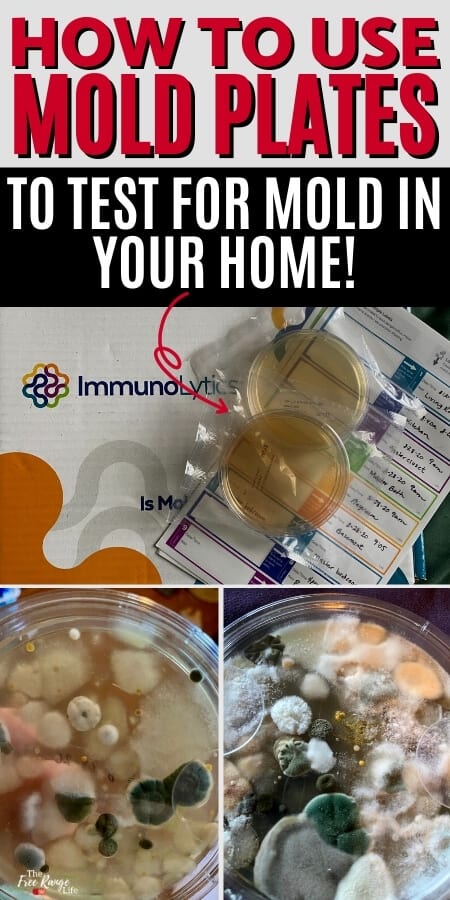
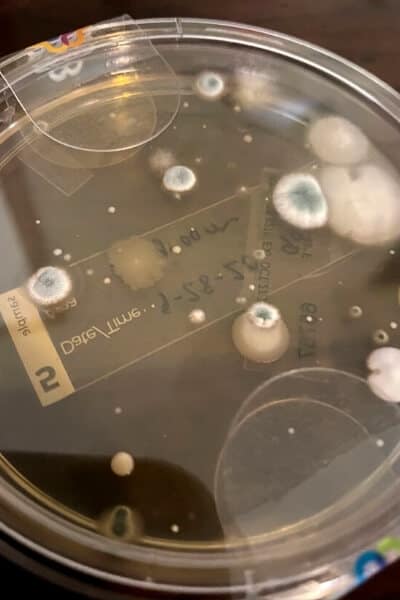
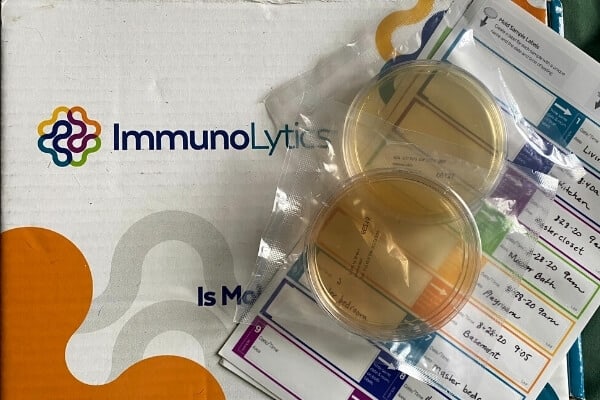
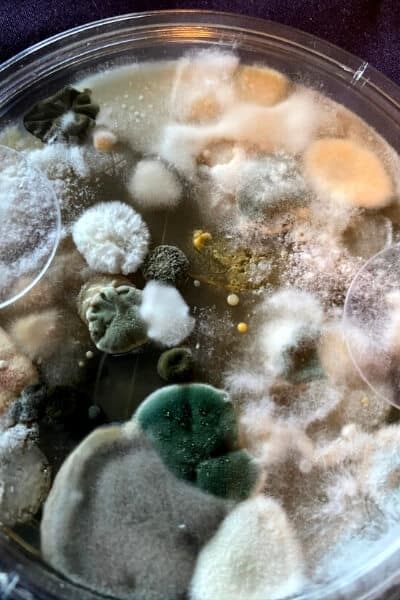
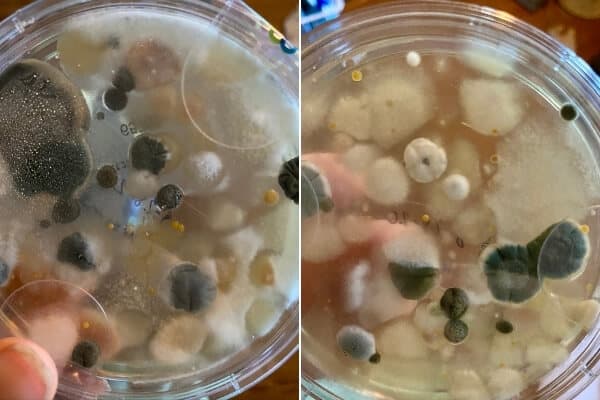


Hi, thanks for your article. Do you know how long air purifiers need to be turned off before testing with these plates? I have the plates all ready to go, just not sure about the purifiers.
What did you do to get rid of the mold once you did this testing?
I would keep them off at least overnight. In our case, we decided to do an ERMI after the mold plates and it came back VERY, VERY high. In the end- due to health issues mostly- we moved.
Great article! Mold test plates are effective tools for detecting and assessing mold contamination in indoor environments. By capturing mold spores on a petri dish, these plates allow for visual identification and analysis. They play a vital role in identifying potential health risks, determining the extent of mold growth, and guiding remediation efforts. Mold test plates are a valuable resource for homeowners, property managers, and professionals in maintaining a safe and healthy living or working environment.
Same here I’m trying sick thyroid acting up!
Dish was full colonies and i had a water leak. Bring house remodeled from the walls to the floor. Phew 😮💨